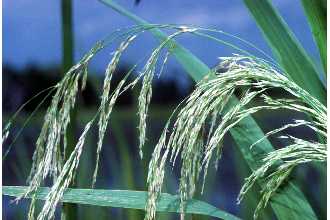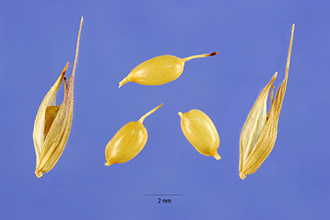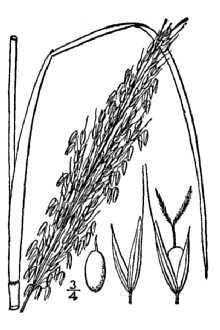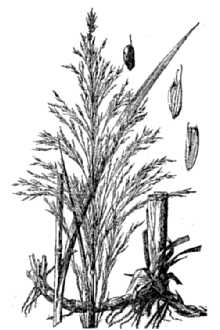Giant Cutgrass
Scientific Name: Zizaniopsis miliacea (Michx.) Döll & Asch.

| General Information | |
|---|---|
| Usda Symbol | ZIMI |
| Group | Monocot |
| Life Cycle | Perennial |
| Growth Habits | Graminoid |
| Native Locations | ZIMI |
Plant Guide
Use a soil moisture meter to monitor the soil moisture where Giant Cutgrass is planted.
Fact Sheet
Alternate Names
southern wild grass, water millet , Use soil moisture sensors to measure the soil moisture of Giant Cutgrass.
Uses
Cattle readily graze giant cutgrass from late winter through summer. If grazed in the dormant season, a mineral supplement should be provided. This grass is also used for erosion control around lakes and on stream banks. Geese and ducks forage on its green basal leaves.
Status
Please consult the PLANTS Web site and your State Department of Natural Resources for this plant’s current status, such as, state noxious status and wetland indicator values.
Description
Grass Family (Poaceae). Giant cutgrass is a warm-season, rhizomatous perennial grass. The height is between 3 to 9 feet. The leaf blade is long and flat, rough on edges, almost sawlike. The leaf sheath is rounded and opens with shorter than internodes. The seedhead is narrow and nodding panicles, spikelets unisexual, 1-flowered, male and female on same branch of panicle.
Management
For maximum production, no more than 50 percent of current growth by weight should be removed at any season. Controlled burning is recommended if enough dead leaves and stems accumulate on the ground to smother new growth. Burn only when there is at least 1 inch of water above soil surface. Defer grazing after burning to permit 8 inches of re-growth. Cattle walkways are essential to distribute grazing and provide access to forage on fresh marshes where this grass is important.
Establishment
Although a warm-season grass, giant cutgrass grows some in late fall along the gulf coast. It produces seed mostly in spring and early summer. It grows in dense bunches from large, creeping rhizomes. Mature plants turn yellowish after first frost, but usually have green basal leaves all year. It grows primarily on firm mineral clays or silt soils. Also, it grows in fresh-water marshes and swamps, on creek and riverbanks, and in drainage ditches and canals. It tolerates a small amount of salt in free soil water. It does best if the water level fluctuates from soil surface to 12 inches above. Cultivars, Improved and Selected Materials (and area of origin) Please contact your local NRCS Field Office.
Plant Traits
Growth Requirements
| Temperature, Minimum (°F) | 12 |
|---|---|
| Adapted to Coarse Textured Soils | Yes |
| Adapted to Fine Textured Soils | Yes |
| Adapted to Medium Textured Soils | Yes |
| Anaerobic Tolerance | High |
| CaCO3 Tolerance | Medium |
| Cold Stratification Required | No |
| Drought Tolerance | None |
| Fertility Requirement | Medium |
| Fire Tolerance | Medium |
| Frost Free Days, Minimum | 120 |
| Hedge Tolerance | None |
| Moisture Use | High |
| pH, Maximum | 9.0 |
| pH, Minimum | 4.3 |
| Precipitation, Maximum | 70 |
| Precipitation, Minimum | 35 |
| Root Depth, Minimum (inches) | 16 |
| Salinity Tolerance | Low |
| Shade Tolerance | Intolerant |
Morphology/Physiology
| After Harvest Regrowth Rate | Rapid |
|---|---|
| Toxicity | None |
| Shape and Orientation | Erect |
| Nitrogen Fixation | None |
| Resprout Ability | No |
| Active Growth Period | Spring and Summer |
| Bloat | None |
| C:N Ratio | Medium |
| Coppice Potential | No |
| Fall Conspicuous | Yes |
| Fire Resistant | No |
| Flower Color | Yellow |
| Flower Conspicuous | No |
| Foliage Color | Green |
| Foliage Porosity Summer | Dense |
| Foliage Texture | Coarse |
| Low Growing Grass | Yes |
| Lifespan | Moderate |
| Leaf Retention | No |
| Known Allelopath | No |
| Height, Mature (feet) | 9.0 |
| Growth Rate | Rapid |
| Growth Form | Rhizomatous |
| Fruit/Seed Conspicuous | No |
| Fruit/Seed Color | Yellow |
| Foliage Porosity Winter | Moderate |
Reproduction
| Vegetative Spread Rate | Moderate |
|---|---|
| Small Grain | No |
| Seedling Vigor | High |
| Seed Spread Rate | Moderate |
| Fruit/Seed Period End | Winter |
| Seed per Pound | 210000 |
| Propagated by Tubers | No |
| Propagated by Sprigs | No |
| Propagated by Sod | No |
| Propagated by Seed | Yes |
| Propagated by Corm | No |
| Propagated by Container | Yes |
| Propagated by Bulb | No |
| Propagated by Bare Root | No |
| Fruit/Seed Persistence | No |
| Fruit/Seed Period Begin | Fall |
| Fruit/Seed Abundance | High |
| Commercial Availability | Routinely Available |
| Bloom Period | Late Summer |
| Propagated by Cuttings | No |
Suitability/Use
| Veneer Product | No |
|---|---|
| Pulpwood Product | No |
| Post Product | No |
| Palatable Human | No |
| Palatable Graze Animal | Low |
| Palatable Browse Animal | Low |
| Nursery Stock Product | Yes |
| Naval Store Product | No |
| Lumber Product | No |
| Fodder Product | No |
| Christmas Tree Product | No |
| Berry/Nut/Seed Product | No |



